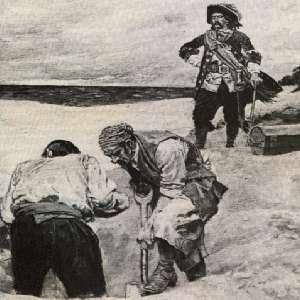 The Golden Age of Piracy
The Golden Age of Piracy
The word Pirate brings to mind buried treasure,
walking the plank, parrots, cutlasses, black eye patches, wooden
legs, pieces of eight, and jolly Roger flags. How close are
these images, though, to the real world of pirates? Who were
these men and how did they live their lives?
Piracy is as old as the history of sailing itself.
Some of the earliest pirates were the Phoenicians who plied
the Mediterranean from about 2000 B.C.. While the Phoenicians
conducted much legitimate trade, they also didn't flinch from
attacking other merchant ships or even coastal towns.
Later, around 150 B.C. the Cilician pirates from
Turkey took control of the Mediterranean until 67 B.C. when
the Roman senate ordered Pompey, a brilliant Roman general,
to hunt them down. He was successful in clearing the sea of
them within three months.
Pirates appeared in great number on the Mediterranean
again during the Middle Ages. While on land, crusades were conducted
by Christian Europeans to get control of the "Holy Land" of
the Middle East, held by Muslims, pirates conducted similar
battles on the Sea. These pirates, known as the Corsairs, were
skilled Muslim and Christian seamen who attacked ships owned
by those of the opposing religion. The booty they gained was
often the crew and passengers of the ships as well as the cargo.
Men and women were sold as slaves or, in the case of those from
rich families, ransomed for cash.
The Golden Age of Piracy
The pirates we are most familiar with, though,
are those from a time that might be called The Golden Age of
Piracy. This period started soon after the discovery of the
New World and continued for about 250 years.
In 1494 the Pope divided the New World between
Spain and Portugal. Predictably this did not sit well with the
other European nations. They wanted a part of the gold the Spanish
were stealing from the Aztecs of South America and conflict
was inevitable.
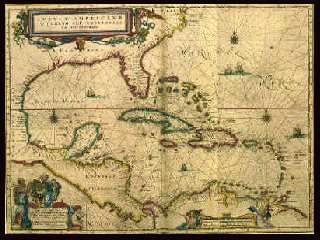 The
part of the New World coast from South America through the Caribbean
to Northern Florida was known as "The Spanish Main" (right).
It was from ports along these coasts that Spanish galleons,
large treasure ships, sailed for Europe. The European powers
began attacking these ships and taking the gold for themselves.
The
part of the New World coast from South America through the Caribbean
to Northern Florida was known as "The Spanish Main" (right).
It was from ports along these coasts that Spanish galleons,
large treasure ships, sailed for Europe. The European powers
began attacking these ships and taking the gold for themselves.
Outfitting ships was expensive and one way to
raise a fleet at little cost was to issue "letters of marque"
that entitled the owner of a private ship to outfit it for war
and use it to attack enemy ships. In return for official permission
the ship's owner split any booty captured with the royal treasury.
Men who engaged in this activity were referred to as "privateers."
Privateers were in effect legal pirates. Or at
least legal to those governments with which they shared the
loot. Sir Francis Drake, who started his career in 1570, was
a hated pirate to Spain, but a hero in England where Queen Elizabeth
addressed him as "my dear pirate." His popularity with the crown
was assured after one expedition where he captured for treasury
300,000 pounds of booty, keeping another 10,000 for himself.
Drake not only raided ships, but attacked Spanish towns and
mule trains carrying gold. So favored was Drake by the Queen
that she presented him with a special sword to use upon her
enemies.
There was a danger in using privateers, though.
Often these independent captains were tempted to attack ships
of countries besides those their nation was at war against.
Also in times of peace it left thousands of men jobless who
had been trained to attack ships and seize goods. The temptation
to turn pirate during these times was immense and many men did
so.
The Buccaneers
In 1630 a treaty was signed with Spain that allowed
the English and French to colonize some of the lands along the
Spanish Main. Many of the European settlers wound up on the
island of Hispaniola (now Haiti and the Dominican Republic).
One of the main sources of food on the island was wild pigs
originally introduced by the Spanish. The settlers barbecued
the pigs on open fires called buccans or boucan.
From this the settlers eventually got the title buccaneers.
The Spanish became nervous over the many buccaneers
on Hispaniola and sent hunters to slaughter the pigs. This backfired
as the buccaneers, with their food supply gone, turned to piracy
to meet their needs. Many of the buccaneers, who also referred
to themselves as the "Brethren of the Coast," moved to the island
of Tortuga, off the coast of Hispaniola and it became a pirate
stronghold. Its fresh water, fertile ground, good anchorages
and defensible harbors made it ideal for their needs.
The buccaneers often used small boats called pinnaces
for their attacks. Using these they could sneak up on unsuspecting
merchant ships and get control of the ship even before the crew
knew they were under attack. When they used larger ships the
pirates often favored smaller, single-masted sloops that could
operate in shallow water. This allowed the ships to be easily
hidden in small hidden bays and inlets. The English buccaneers
liked attacking with the dozen or so cannon on deck, while French
pirates preferred hand-to-hand combat with small arms and knives.
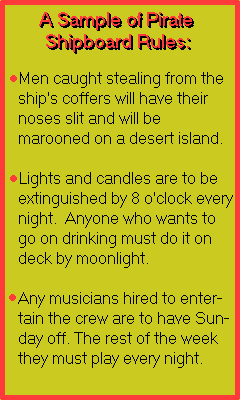 While
some pirates were excessively cruel outlaws, many were just
plain sailors who could not find an honest living. The life
of a sailor in those times was hard. The power of the captain
of a merchant ship or a military vessel was nearly absolute.
Crewmen could be whipped by a cruel captain for the least offense.
While
some pirates were excessively cruel outlaws, many were just
plain sailors who could not find an honest living. The life
of a sailor in those times was hard. The power of the captain
of a merchant ship or a military vessel was nearly absolute.
Crewmen could be whipped by a cruel captain for the least offense.
In contrast many pirate ships were run democratically.
Before a voyage the crew held a council that included all the
members. As a group they decided where to sail, who should be
captain, and how any booty should be divided up. The captain
usually got a double share and crew members with special skills,
such as a doctor or carpenter got one and one half. The council
also drew up a list of rules that all the crew agreed to obey.
Sir
Henry Morgan
Probably the most famous
of the buccaneers was Sir Henry Morgan. Morgan was born in Wales
in 1635. In his teens he joined a pirate crew from Tortuga and
swore an oath as a member of the "Brethren of the Coast." After
a successful trip, Morgan and some friends decided to outfit
their own ship. Morgan was elected captain and his first raid
was a great success. Many more followed. Morgan became a vice
admiral in the buccaneer fleet and quickly became very famous
and rich.
In 1668 the governor of the island of Jamaica
got wind of Spanish plans to attack the island. He offered Morgan
a letter of marque making him a legal privateer if Morgan would
attack the Spanish first and share any spoils with the governor.
Morgan agreed and the campaign was a success, though Morgan
had a close escape.
While raiding the city of Maracaibo in Venezuela,
Morgan's ships were trapped in the harbor by Spanish vessels.
Morgan had his crew clean out a captured merchant ship and fill
it with pitch, tar and gunpowder: an explosive combination.
Fake cannons made out of Indian drums and dummies of the crew
(with pumpkins for heads) were placed on deck. A handful of
men then steered the ship toward the Spanish forces, lit fuses
attached to the gunpowder kegs, and escaped in small boats.
The Spanish ships engaged the vessel. The ship blew up at close
range sinking two of attackers. Then Morgan attacked the remaining
Spanish vessels. The battle raged for days, but Morgan's forces
escaped.
Later, Morgan settled down on a plantation he'd
purchased in Jamaica. King Charles II knighted him and he later
became Deputy Governor of Jamaica. He died in 1688 a contented
man.
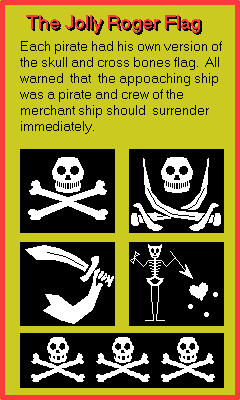 Few
pirates enjoyed a retirement like Morgan's. Some were caught,
tried and hung for their misdeeds and their bodies were often
left to rot hanging about the dock as a warning to other sailors.
Many more, though, died of disease or alcoholism.
Few
pirates enjoyed a retirement like Morgan's. Some were caught,
tried and hung for their misdeeds and their bodies were often
left to rot hanging about the dock as a warning to other sailors.
Many more, though, died of disease or alcoholism.
Many ports welcomed pirates because of the wealth
they had to spend. Port Royal, Jamaica, became a leading buccaneer
base after it was captured by the British from the Spanish in
1655. So much plundered gold and silver was flowing into the
city by 1662 the government established a mint there. Brothels,
gambling houses and bars quickly sprang up to satisfy the needs
of the buccaneers. In July 1661 alone, forty new licenses were
granted for taverns in the city. So wild was the situation in
the port a minister arriving to meet spiritual needs there immediately
departed on the same ship declaring that "since the majority
of its population consists of pirates, cutthroats, whores and
some of the vilest persons in the whole of the world, I felt
my permanence there was of no use."
This pirate heaven wouldn't last forever and by
1700 buccaneering was almost gone in the Caribbean. The amount
of treasure being shipped back by Spain from the New World dwindled,
so there were fewer ships to attack. Nations started to depend
less on privateers and more on full-time navies.
Piracy wasn't completely banished from the New
World's coast, though. In 1713 the Treaty of Utrecht brought
an end to the War of Spanish Succession. Suddenly there were
thousands of seamen unleashed from military service and few
jobs. Many went to sea again as pirates. It is from this period
that some of the most famous pirate captains emerged: Captain
Kidd, Black Bart Roberts, Calico Jack and, of course, Blackbeard.
While Blackbeard had perhaps the worst reputation,
he was not the cruelest pirate of his era. That title belonged
to Captain Edward Low, a psychopathic pirate who enjoyed torturing
his captives to get them to reveal hidden valuables.
Blackbeard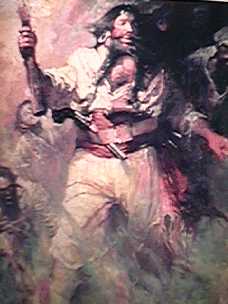
Blackbeard was the best, though, at self promotion.
Having a terrifying reputation was important for a pirate. The
more fear he struck into the crew of a ship, the more likely
they would surrender without a fight. Blackbeard (left)
was a big man, with a naturally scowling face, long, thick black
hair and beard, and wild, deep-set eyes. To further heighten
his terrifying presence, Blackbeard would go into battle with
lighted tapers in his hair. These belched black smoke, making
Blackbeard appear to his enemies as some kind of demon.
Blackbeard, whose real name is thought to be Edward
Teach, began his career as a privateer, but after the Treaty
of Utrecht joined the crew of a pirate ship. He soon had his
own ship called Queen Anne's Revenge. In May of 1718,
Blackbeard was bold enough to blockade the harbor of Charleston,
South Carolina, using the Queen Anne's Revenge and two
smaller vessels, and demand ransom. He got it. He also got a
pardon from the North Carolina governor, Charles Eden, in return
for a cut of his booty.
The pardon didn't prevent Blackbeard from harassing
plantation owners along the Pamlico River, though. The plantation
owners appealed for help from Governor Spotwood of Virginia.
Spotwood, a pirate foe, spent his own money to finance an expedition
to Ocracoke Inlet, North Carolina, to put an end to Blackbeard.
Lieutenant Robert Maynard, of the British Navy,
with sixty-two men attacked the pirates there using two small
ships. Despite only having eighteen men with him, Blackbeard
nearly won the engagement. Blackbeard fought like a cornered
beast and took 20 cutlass wounds and five pistol shots before
he died. When he was dead his head was removed and hung from
Maynard ship's bowsprit as proof of his death.
The British Navy continued to hunt down pirates
in the Caribbean and along North American coasts. Harsh laws
were enacted to punish those who bought or sold to pirates.
These measures, along with rules forbidding cruel punishments
on Navy vessels, brought the Golden Age of Piracy to an end.
Piracy continued in the Indian Ocean for a while,
and some of it even exists today in Southeast Asia. What makes
the pirates of the golden age stick in our minds?
Pirate Fiction
The answer is literature. Not everything we read
in fictional accounts are accurate, though. Few pirates ever
made prisoners walk the plank, and only one pirate that we know
of, Captain Kidd, ever buried a treasure (though pirates are
associated with the mystery of Oak Island
pit in Nova Scotia).
Books like Treasure Island by Robert Louis
Stevenson, published in 1883, and later J.M. Barries' play Peter
Pan, first performed in 1904, featured colorful pirates
from this age giving them an aura of glamour and romance. Movies
later continued this tradition, forever fixing in our minds
these rogues, and this era.

Copyright Lee Krystek
1998. All Rights Reserved.



 The Golden Age of Piracy
The Golden Age of Piracy  The
part of the New World coast from South America through the Caribbean
to Northern Florida was known as "The Spanish Main" (right).
It was from ports along these coasts that Spanish galleons,
large treasure ships, sailed for Europe. The European powers
began attacking these ships and taking the gold for themselves.
The
part of the New World coast from South America through the Caribbean
to Northern Florida was known as "The Spanish Main" (right).
It was from ports along these coasts that Spanish galleons,
large treasure ships, sailed for Europe. The European powers
began attacking these ships and taking the gold for themselves.
 While
some pirates were excessively cruel outlaws, many were just
plain sailors who could not find an honest living. The life
of a sailor in those times was hard. The power of the captain
of a merchant ship or a military vessel was nearly absolute.
Crewmen could be whipped by a cruel captain for the least offense.
While
some pirates were excessively cruel outlaws, many were just
plain sailors who could not find an honest living. The life
of a sailor in those times was hard. The power of the captain
of a merchant ship or a military vessel was nearly absolute.
Crewmen could be whipped by a cruel captain for the least offense.
 Few
pirates enjoyed a retirement like Morgan's. Some were caught,
tried and hung for their misdeeds and their bodies were often
left to rot hanging about the dock as a warning to other sailors.
Many more, though, died of disease or alcoholism.
Few
pirates enjoyed a retirement like Morgan's. Some were caught,
tried and hung for their misdeeds and their bodies were often
left to rot hanging about the dock as a warning to other sailors.
Many more, though, died of disease or alcoholism.

